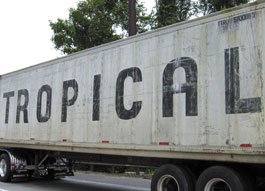home | north bay bohemian index | the arts | visual arts | review

Photograph by Pablo Guardiola
LADY OF THE HIGHWAY: Pablo Guardiola's installation 'Es Lo Que Es' utilizes recorded sound and photography.
System of Sound
'Sonida Pirata' amplifies Mexico's underground street economies
By Leilani Clark
Ever-present in the side streets and plazas of Mexico are large outdoor markets under tarp-roofed booths, selling food, lucha libre masks, purses, T-shirts and bootleg CDs with handmade covers. One of the most famous of these markets is the long-standing Tianguis Cultural del Chopo, aka "El Chopo," a Saturday-afternoon flea market that over the past 25 years has become the epicenter of Mexico City's punk and goth scenes.
"I've been to El Chopo many times, and I was blown away when I realized the whole history of it, this kind of cultural resistance where they make their own community," says Julio Cesar Morales, the San Francisco–based curator of "Sonido Pirata: What You Need You Have to Borrow," a multimedia exhibition premiering at the Sonoma Valley Museum of Art this month. "When I first saw it, it almost felt like a community art project," adds Morales, regarding the buttons, records and other items that are traded or sold for very cheap at the market.
Underground economies as a site of cultural resistance hold a particular fascination for Morales, who was born in Tijuana, and guide his selection of artists of the exhibition, which includes Nao Bustamante, Sofia Cordova, Torolab, and Cristina Victo. Juan Luna-Avine, a multidisciplinary artist who grew up in Mexico City and who recently showed at SFMOMA, finds particular inspiration in the DIY ethic of El Chopo, says Morales.
"He's been following the underground punk rock subculture and music since he was a teenager, and his installation is going to be a series of drawings, painting and sculpture, plus work that you can actually buy, like mixed CDs that he makes, for a couple of dollars," explains Morales. "Juan is pirating his own music collection. He's using the same kind of setup that they use in Mexico—industrial blue or orange tarps and just a very basic stand with CDs."
Another installation by University of Southern California professor and occasional New York Times music critic Josh Kun digs into the wave of "Tijuana sound" bands that rose up after Herb Alpert and the Tijuana Brass hit it big with "The Lonely Bull" in 1962.
"He has a collection of fake Tijuana concept albums by American artists," says Morales. "They were trying to recreate what Alpert did, with the trumpets and the marimbas, but most of them had never been to Tijuana."
In reality, a visitor to the Baja-California border town in 1965 would have heard bands playing blues and R&B a la James Brown, rather than the romanticized "south of the border" songs of the Baja Marimba band. Kun's display of 30 albums, with an accompanying iPod listening-station, acts as an appropriation of an appropriation, offering a visceral experience of the strange ways culture can become twisted at the border.
On the exhibit's opening day, Kun offers a lecture titled "The Aesthetics of Alla" on mobile-sound-system DJs—sonideros—who use recorded sound and technology to "engage with borderland and migration politics."
A music and pop-culture emphasis might seem risky for an art museum outside the more adventurous climes of San Francisco ("I'm hoping the people in Sonoma will be open to this," Morales says), but when it comes to piracy, black market economies and the underground, risk is the only thing that's guaranteed.
'Sonido Pirata: What You Need You Have to Borrow' opens Saturday, Sept. 17, and runs through Jan. 1, 2012, at the Sonoma Valley Museum of Art. 551 Broadway, Sonoma. Wednesday–Sunday, 11am–5pm. $5. 707.939.7862.
Send a letter to the editor about this story.
|
|
|
|
|
|